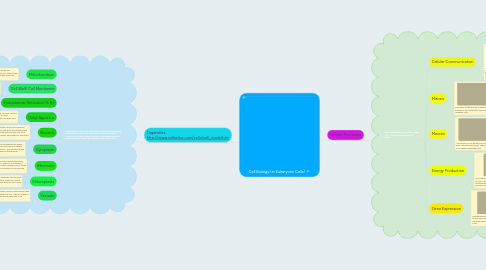
1. Organelles http://www.cellsalive.com/cells/cell_model.htm
1.1. Organelles are sub units of the cell that preform the necessary functions for a cell to live. Each organelle has specialized function that it was created to preform: packaging materials, creating energy, support cell structure, cell division, etc...
1.1.1. Mitochondrion
1.1.1.1. The work house of the Cell. Creates the molecules and chemicals that used to provide energy for the cell. They do this through cellular respiration to produce the energy molecule ATP.
1.1.2. Cell Wall/ Cell Membrane
1.1.2.1. Cell Wall exist only in plants while Cell Membranes exist in both animals and plants. Both function as a support structure for the cell as a whole. It also acts as protective barrier. Letting in only things that the cell needs to function.
1.1.3. Endoplasmic Reticulum (E.R.)
1.1.3.1. The E.R. is large folded membrane organelle within the cell. It is responsible for the production of many important lipids (fats) and some proteins. Their are two types of E.R., smooth and rough.
1.1.4. Golgi Appartus
1.1.4.1. Sometimes referred to as the Golgi body, its main function is sort, package, and send the lipids and proteins (sometimes it modifies them as well) that it receives from the E.R.
1.1.5. Nucleus
1.1.5.1. Is actually composed of two parts the Nucleus itself and the nuclear envelop, which is a double membrane pockmarked with many open pores. This is the storage place for the cells DNA. Which holds all the genetic information about that cell and how it will function.
1.1.6. Cytoplasm
1.1.6.1. This is a thick solution within each cell that composes of everything from within the cell membrane up until the nuclear envelope. The solution that is not within the other organelles themselves is referred to as the cytosol. Also included in this organelle are a framework of proteins called the cytoskeleton that provide structure to the cell.
1.1.7. Ribosome
1.1.7.1. This a small cell organelle composed of two subunits that come together while completing its function. Which is to translate a coded message from the cell's nucleus that translates into a string of amino acids that will eventually be processed into functioning proteins.
1.1.8. Chloroplasts
1.1.8.1. These are organelles unique to plant cells much like mitochondria they produce needed molecules for functions within the cell but they harness energy from light to do so, through a process called photosynthesis.
1.1.9. Vacuole
1.1.9.1. These are large bubble like structures found is cells that are used for storage and transportation within the cell. They are found in both plant and animal cells but are much larger and more common in plant cells.
2. Cellular Processes
2.1. Any Process that occurs at the cellular level. Is not restricted to one cell alone.
2.1.1. Cellular Communication
2.1.1.1. Communication refers to the way in which cells receive and transmit messages both outside and within. Cells can respond to many or transmit messages through many different types of chemical or physical stimuli.
2.1.2. Mitosis
2.1.2.1. This refers to the process in which a single eukaryotic cell divides into two identical diploid daughter cells.
2.1.3. Meiosis
2.1.3.1. Is a process of cell division much like mitosis but with a different end result. Here the end result is four haploid daughter cells
2.1.4. Energy Production
2.1.4.1. The production of energy in the cell is a long and complicated process. Plant cells do so through a process called Photosynthesis while eukaryotic animal cells do so through a process called cellular respiration.
2.1.5. Gene Expression
2.1.5.1. This the expression of the sequences of DNA (genes) to RNA and finally into proteins or protein chains. These expressions help determine the main function of a cell.
